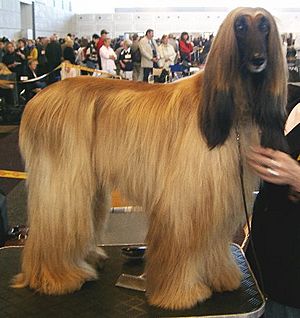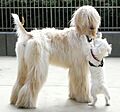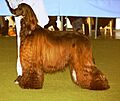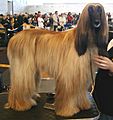Afghan Hound facts for kids

Afghan Hound, fully coated
|
|||||||||||||||||||||||||||
| Other names |
|
||||||||||||||||||||||||||
|---|---|---|---|---|---|---|---|---|---|---|---|---|---|---|---|---|---|---|---|---|---|---|---|---|---|---|---|
| Origin | Afghanistan | ||||||||||||||||||||||||||
|
|||||||||||||||||||||||||||
|
|||||||||||||||||||||||||||
| Domestic dog (Canis lupus familiaris) | |||||||||||||||||||||||||||
The Afghan Hound is a special type of hound. It is known for its long, silky coat and a tail that curls into a ring at the end. This dog breed was carefully developed in the cold mountains of Afghanistan.
People also call this breed by other names like Tāzī, Balkh Hound, or Kabul Hound. Afghan Hounds are very good at running and turning quickly.
Contents
History of the Afghan Hound
The Afghan Hound is considered a very old dog breed. It existed long before many modern dog breeds appeared in the 1800s. This breed is most closely related to the Saluki, another ancient hound.
Dogs similar to the Afghan Hound can be found in nearby areas. For example, the Tazi breed from Russia and Turkmenistan looks very much like the Afghan Hound. This suggests they might share a common ancestor. Other similar dogs include the Taigan from the Tian Shan mountains and the Barakzay Hound.
There are at least 13 different types of Afghan Hounds in Afghanistan. Some of these are now being developed into modern purebred dogs.
When Afghan Hounds first left Afghanistan, their story became linked with early dog shows in England. In the 1800s, army officers brought different sighthounds to England from places like British India and Iran. These dogs were shown at dog shows, which were just becoming popular.
One famous dog named Zardin was brought from India in 1907. He became the ideal example for what was then called the Persian Greyhound. Zardin helped create the first breed standard in 1912. However, breeding stopped during World War I.
Two main types of long-haired sighthounds from Afghanistan created the modern Afghan Hound breed. The first type came from Balochistan in 1920. These dogs were from the lowlands and had less heavy coats. They were known as the Bell-Murray strain.
The second type came from a kennel in Kabul owned by Mrs. Mary Amps. She sent her dogs to England in 1925. Her dogs, known as the Ghazni strain, were the heavily coated mountain type. Many Afghan Hounds in the United States came from this Ghazni strain. The mountain and steppe types eventually mixed to form the Afghan Hound we know today. A new breed standard was written in 1948 and is still used.
Some Afghan Hounds have a more "patterned" coat. This look comes from both the Bell-Murray and Ghazni lines. These dogs have lighter feathering, a deeper "saddle" mark on their back, and shorter hair on their face and neck. It is thought these dogs came from hotter parts of Afghanistan.
Afghan Hounds became very popular show dogs and pets because of their beauty. They are recognized by major dog clubs around the world. An Afghan Hound named Sirdar won Best in Show at Crufts in 1928 and 1930. An Afghan Hound was even on the cover of Life Magazine in 1945. They were very popular in Australia in the 1970s. Afghan Hounds also won Best in Show at the World Dog Show in 1996 and at the Westminster Kennel Club Dog Show in 1957 and 1983.
Today, Afghan Hounds are not usually used for hunting. However, they often take part in the sport of lure coursing, where they chase a fake lure.
What Afghan Hounds Look Like
Afghan Hounds are tall dogs. They stand about 61–74 cm (24–29 in) tall and weigh around 20–27 kg (44–60 lb). Their long, fine coat can be almost any color. However, white markings, especially on the head, are not preferred. Many Afghan Hounds have a black mask on their face. Some even have facial hair that looks like a mustache.
Their long, fine coat needs a lot of care and grooming. The long hair on top of their head, called a topknot, and the shorter hair on their back, called a saddle, are special features of their coat. Their high hipbones and the small ring curl at the end of their tail are also unique to the breed.
Afghan Hound Personality
A typical Afghan Hound can seem distant and proud. But they are also happy and playful when they are comfortable. Like many sighthounds, they have a strong instinct to chase prey. This means they might not get along well with small pets.
Afghan Hounds can do very well in dog agility competitions. They can also be good therapy dogs and loving companions. Studies of dog DNA show that the Afghan Hound is one of the oldest dog breeds.
Even though they are rarely used for hunting in Europe and America today, Afghan Hounds often compete in lure coursing events. They are also popular in dog shows.
Afghan Hound Types
Khalag Tazi
The Khalag Tazi is a type of Afghan Hound that came to Europe in 1920. An officer named Major G Bell-Murray brought some of these dogs from Afghanistan. "Tazi" is an old name for hunting dogs of the sighthound type in the Middle East. It has been used for breeds like the Saluki and Persian Greyhound.
Bakhmull
The Bakhmull, also called the Aboriginal Afghan Hound, is a long-haired type of sighthound. It has been bred mostly in Russia. People say it represents an original Afghan Hound from Afghanistan. In the Pashto language, "bakhmull" means "velvet." This name refers to the dog's silky coat. The coat is long and thick over most of the body, except for the middle of the back, the front of the legs, and the muzzle.
Bakhmull dogs are usually fawn, ivory, or white in color. They often have a darker "saddle" on their back. This coloring helps them blend in with the sandy and rocky landscapes of the Hindu Kush mountains and deserts. Colors like red, black, or red/black with white spots are not allowed for this type.
Since the 1980s, Russia has been the main place for Bakhmull breeding. The first dogs were brought to Russia in the 1970s by soldiers returning from Afghanistan. A special club was formed to protect and develop the Bakhmull breed. A breed standard, which describes what the dog should look like, was first published in 1985.
Bakhmulls are expected to be graceful and strong. They should have a balanced look and be smart. They are usually calm and friendly with people, unless trained as guard dogs. They are also aggressive hunters in the field. Bakhmulls can hunt alone or in pairs. Even though their coat is long, it does not need much grooming. Their paws have thick fur, which protects them from injuries. Their long, velvety coat and strength make them good for harsh weather.
The breed standard says they should have an "aristocratic gait" and a "beautiful head with gazelle-like eyes." Their eyes should be large, brown, almond-shaped, and slant upwards. Their nose and lips must be black. Male Bakhmulls are usually 68–73 centimetres (27–29 in) tall, and females are 65–70 centimetres (26–28 in) tall. Their gait should be easy and bouncy. When hunting, they can gallop very fast, covering long distances with great speed and agility.
Lifespan
Bakhmull dogs usually live for 13 to 18 years for males, and 14 to 19 years for females.
Closely Related Breeds
The Saluki is a breed from the Middle East with very old roots. It is the breed most closely related to the Afghan Hound among modern, well-known breeds.
Afghan Hounds in Popular Culture
Because of their unique look, Afghan Hounds have appeared in many movies and TV shows.
- In Universal Pictures' Balto, there is a character named Sylvie.
- Ruby in Disney's Lady and the Tramp II: Scamp's Adventure is an Afghan Hound.
- They also appeared in 101 Dalmatians and 102 Dalmatians.
- Prince Amir of Kinjan in the TV series What-a-Mess is an Afghan Hound.
- Prissy in the 1961 Disney animated film One Hundred and One Dalmatians and 101 Dalmatians II: Patch's London Adventure is an Afghan Hound.
- Brainy Barker from Krypto the Superdog says she is an Afghan Hound, though she looks more like a Saluki.
- Malory Archer in the show Archer had an Afghan Hound named Duchess.
- Persia, the leader of the Space Rovers in Road Rovers, is an Afghan Hound.
- Burt, an Afghan Hound in the show Foofur, tries to win Dolly's love.
Afghan Hounds have also been in TV commercials and fashion magazines. They are featured in books too, like a series of mystery novels by Nina Wright. In the novel Between the Acts, Virginia Woolf uses an Afghan Hound named Sohrab to represent parts of a human character.
On August 3, 2005, a Korean scientist named Hwang Woo-Suk announced that his team had successfully cloned a dog for the first time. The cloned dog was an Afghan Hound named Snuppy. While there were later questions about the research, Snuppy was confirmed to be the first cloned dog in history.
An Afghan Hound is also shown in the music video "Set in Stone (M83 Remix)" by the French band M83.
Images for kids
See also
 In Spanish: Lebrel afgano para niños
In Spanish: Lebrel afgano para niños









